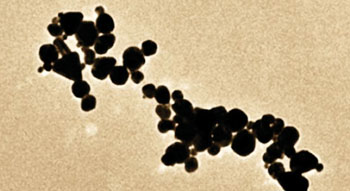Gold Nanoparticles Indicate Early Detection of Heart Attacks
By LabMedica International staff writers
Posted on 28 Jan 2015
A test strip for a heart attack biomarker is being developed as its level is several thousand times higher in patients experiencing myocardial infarctions. The new strip uses microplasma technology. Posted on 28 Jan 2015
Cardiac troponin I (cTn-I) is a specific marker for myocardial infarction and a new cTn-I test is based on the specific immune-chemical reactions between antigen and antibody on immunochromatographic test strips using gold nanoparticles (AuNPs).

Image: Microscopic view of microplasma-gold nanoparticles on a new, highly sensitive test strip that enables early detection of heart attacks (Photo courtesy of New York University Polytechnic School of Engineering).
Bioengineers at the New York University Polytechnic School of Engineering used an atmospheric-pressure non-thermal microplasma for the synthesis of aqueous gold nanoparticles (AuNPs). The microplasma-induced liquid chemistry was analyzed by monitoring the pH value and the conductivity of the liquid. A sample pad made of glass fiber was saturated with 100 mM phosphate buffered saline and the anti-cardiac troponin antibody19C7 MAb (HyTest Ltd.; Turku, Finland) was conjugated to AuNPs and sprayed onto the conjugate pad. After the addition of other antibodies, the nitrocellulose membranes were combined with the conjugate pad at the opposite end downstream of the control line. The sample pad was placed on top and in front of the conjugate pad at the site of the sample application wells.
Compared to AuNPs produced by traditional chemical methods, the surfaces of the gold nanoparticles generated by the microplasma-induced liquid chemical process attracted more antibodies, which resulted in significantly higher detection sensitivity. A positive result yields reddish bands at both the test (T) and control (C) positions, whereas a negative result yields a reddish band at position C only. The level of cTn-I is below 0.06 ng/mL in the blood of healthy people, whereas the level of cTn-I may reach 100 ng/mL to 1,300 ng/mL in patients after the onset of acute myocardial infarction (AMI) and remains high for up to four to10 days.
The authors concluded that the immune-chromatography test assays for cTn-I prepared by AuNPs generated by plasma-liquid interaction exhibit higher detection sensitivity than those prepared by chemically reduced AuNPs detection. They believe that the microplasma-assisted synthesis of AuNPs have great potential for a variety of biomedical and therapeutic applications. The study was first published online on December 11, 2014, in the journal Plasma Processes and Polymers.
Related Links:
New York University Polytechnic School of Engineering
HyTest Ltd.







 Analyzer.jpg)





